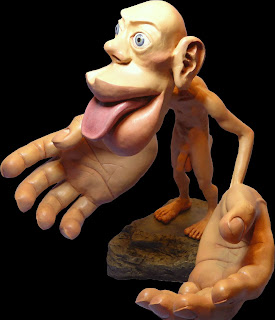Consciousness: a primer
A couple of years ago, particularly during the holiday between the first and second year in college, I decided to watch a neuroscience course called Understanding the Brain for the neuroscientist Jeanette Norden. It's a great course, especially to those who would like to get a philosophical and thought-provoking introduction to the field before getting loaded with the details of neuroanatomy and physiology.
 |
| Credit: Wikimedia Commons. |
I was quite surprised at the fact that I never quite thought about such primitive questions as "how do I see things?" and even where the "seat of thinking" lied. Now, after two years of reading and listening of lectures and videos on the subject, I know why. It all stems from our tendency to introspect.We assume that there's a little man (or homunculus, if you prefer the proper term) inside our heads that represents the real "us" who actually analyses the data, external to the actual hardware that's there (the human brain).
When we started to study the way the visual cortex worked, the idea got even deeper, as I started to see how the brain literally breaks apart the picture into many aspects; color, motion, lines, contours, faces etc ... But then, what happens next? I was faced with a really puzzling question. If our brain breaks apart the picture, how does it finally "come together"?! How come we have this vivid view of the world around us without the separation suggested by the data? So I made this hypothesis that there's something that I called the perception center where the final analysed data gets sent to for the final perception of the event. And a deep discussion started between me and a couple of friends; a discussion that lasted almost an entire year with various theories and postulates, and very little data. As time progressed, the and we learned more about the brain, the following big picture emerged:
- When it comes to visual data of important objects such as faces, the different aspects of the face are broken into lines, colors, motion and so on, but they eventually converge to a single cell in secondary visual cortex called the facial recognition area that is specific to the face, no matter how it moves, and regardless of the lighting and orientation! So, does this cell represent the homunculus? Some argue this only works for faces, for it would be virtually impossible to have a cell for every object we see in our lives. But we know one thing for sure: injury to this area of the visual cortex leads to failure of recognizing faces. That is, you can see the nose and the eye and the mouth, but can't quite link them to a face. In fact, you might see your own picture and fail to recognize yourself! By the way, this concept is called the Grandmother cell for those interested in finding out more about it.
- The thalamus is the gateway to the various areas of the brain. Everything passes through the thalamus and there are lots of back-connections from the cortex to the thalamus, particularly the rear end known as the pulvinar. This lead me and a friend, back in second year, to make the proposition that the thalamus is the so-called perception center. And now, after some more reading, I realize just how close we were to some credible theories of perception. Something that caused me particular euphoria was the fact that this problem actually has a name! It's called The binding problem if you want to find out more.
- Our perception can be shown in many cases to be rather separate from the incoming sensory signals. For example, look at the photo below of a necker cube. If you focus on it long enough, you can see it from a side view or from a top-down view, and your brain might alternate between the two.
 |
| Necker cube. Credit: Wikimedia Commons. |
- Thus, despite the sensory input being the same, your perception can fluctuate. This is, in essence, the basis of all visual illusions. Further, try to close your eyes and imagine yourself doing any form of activity. Now, in this case, there is no visual input at all, yet your brain is synthesizing the images vividly enough for you to perceive them.
There are tons of other clues and data, of course, but let's deal with these at the moment. Anyone who has studied how the cortex works in some detail will know that it works in a rather parallel fashion. As I stated earlier, the picture gets broken down into its various components that get analysed simultaneously. Our brains, as Dan Danette argues, work in a parallel fashion, but give us the illusion of serial processing. As to how they do just this, I would like to introduce you to a book called The Astonishing Hypothesis: The scientific search for the soul by Francis Crick. Now, I know many of you know Crick for his work on DNA, but I gotta tell you, his work in neuroscience is also quite long-reaching. Anyhow, remember the connections and back connections with the thalamus I talked about? Well, it turns out that most of these work in a reverberatory circuit fashion; once you start the signal in of them it keeps propagating for sometime in what could be thought of as a very-short-term form of memory. So Crick's proposition is that the various aspects of the image get sent to the thalamus via those reverberating circuits, which keep firing in synchrony for brief moments, such that the organism gets the illusion of a single image.
So where's the soul in all of this? I think most of us equate the soul with the homunculus that I talked about earlier. We think the soul is that little man inside us that perceives things for us. But, it turns out, there is no little man, and the very problem of consciousness could be tackled with science. But while we cannot know what the soul really IS, or whether it exists in the first place, we can surely say what it's NOT. The soul is NOT consciousness. I reached this conclusion by the end of the second year and was quite happy to find agreement in Crick's book.
Why do we even need to have the illusion of serial processing? Why don't we simply operate based on the parallel processing of each aspect of the image independently? Arguably, lower animals do just that, while social beings like primates have the serial illusion. But why? The psychologist Nicolas Humphrey argues in his book The Inner Eye, that while consciousness may not be THAT important for dealing with inanimate objects, it's always useful to know what the other person is perceiving. So by creating the illusion of a unified world inside your own head, you can imagine what other being in your environment perceive, and would therefore be able to interact with them appropriately. How you do just that is based on introspection and empathy, the neuroscientific basis of which is something called mirror neurons found in the frontal lobes of your brain.
So the next time you think you perceive the world in full, think again!




Comments
Post a Comment